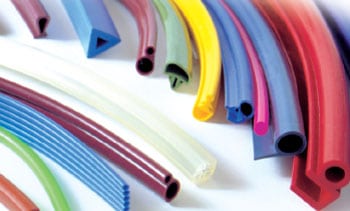Over a long period of time, rubber has indeed been utilised in the manufacture of a broad variety of goods, including automobiles. Rubber is a generic term that refers to a variety of different polymers. They are all elastomers, which means they can be stretched out and then returned to their original form when the tension is released. Natural rubber, produced from the fluid of hevea trees in Central andSouth America, was the first kind of rubber discovered. We still use natural rubber today, but because to technological advances, we can also utilise a variety of other types of rubber that have been developed by combining various compounds with varied characteristics with natural rubber. Synthetic rubber is a term used to describe rubber that has been artificially created and “inspired” by natural rubber.
Industrial rubber profiles products must meet a wide range of performance requirements because of the wide variety of industrial rubber products implementations. These requirements range from common fracture toughness to fluid resistance, permeability, frictional force, penetrability, and dynamic characteristics, amongst many other characteristics.
Choosing the Most Appropriate Industrial Rubber Profiles
Numerous variables must be taken into account when selecting a superb bespoke industrial rubber profiles for your project. Most essential, you must select a rubber compound that will meet all of the requirements of your particular application. Please remember that choosing the finest materials is dependent on a variety of factors.
For example, you may be contemplating using synthetic rubber for the profiles of your rubber gaskets. Synthetic rubber is a flexible polymer that is resistant to wear, erosion, and water, as well as having the capacity to withstand high temperatures and pressures. It is also more cost-effective than natural rubber, with costs that are less than natural rubber. If, on the other hand, your application includes exposures to acids, oils, lubricates, fats, or ozone, the product will not function as expected.
Natural Rubber vs. Synthetic Rubber: Comparison of Properties
Because of the broad range of uses in the industrial sector, synthetic rubbers are available in a variety of shapes and sizes.
Because synthetic rubber is utilised in a variety of applications, its characteristics change from one use to the next. However, there are a few significant distinctions between natural and synthetic rubber that should be noted in order to properly compare the two types of rubber.
The Characteristics of Natural Rubber
Because of its great tensile strength, natural rubber is very resistant to wear caused by chipping and ripping. Heat, light, and ozone exposure, on the other hand, are more prone to cause damage. Because of its sticky characteristics, particularly toward steel wires, it is often found in automobile tyres.
Synthetic Rubber is a kind of rubber that has been synthesised
In comparison to natural rubber, synthetic rubber is more resistant to abrasion. The fact that it is grease and oil resistant also makes it a popular option for use in corrosive conditions.
Synthetic rubber also has excellent heat and time endurance; in fact, several types of synthetic rubber are flame-resistant. Because of this, it is a popular option for electric insulation. Synthetic rubber is also very flexible, even when exposed to extremely low temperatures.
Synthetic rubber is more frequently used nowadays because of its availability and simplicity of manufacturing, as well as in specific situations when resilience to high temperatures and corrosion is required, such as in the construction industry.
What is the process of preparing rubber for industrial use?
There is no direct extraction of natural rubber extract for the production of the rubber products. For example, various ways of manipulating the tensile strength and hardness must be tried on it before it is ready for use. A vulcanization method was used, in which sulphur is introduced into the rubber and the rubber is transformed into vulcanised rubber. This rubber is excellent for use in the production of tyres and other products.
The sulphur molecules form a bond with the polymer component found in latex, causing the natural product to harden as a result. The tensile strength rises by orders of magnitude. Because of its versatility and exceptional durability, this rubber may be utilised for a variety of applications. If you look at the list of rubber goods, you will see how this natural commodity is changed to meet the demands of many industries.
0






